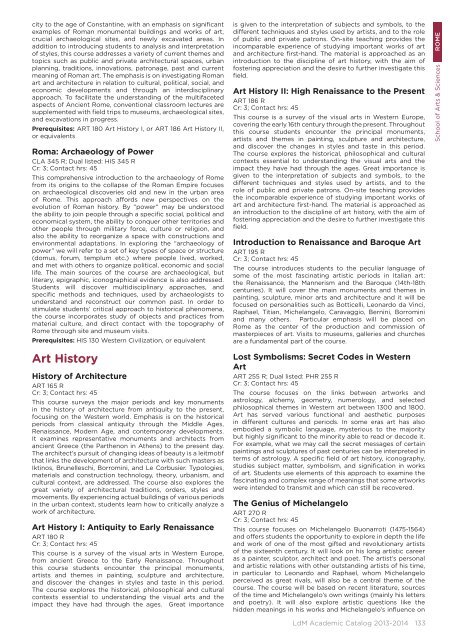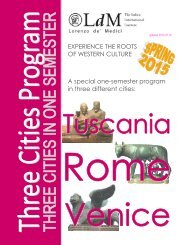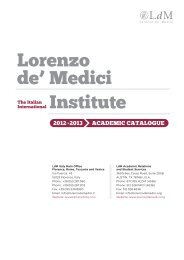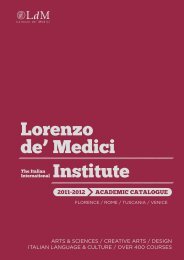aCademiC Catalog 2013-2014 - Lorenzo de Medici
aCademiC Catalog 2013-2014 - Lorenzo de Medici
aCademiC Catalog 2013-2014 - Lorenzo de Medici
You also want an ePaper? Increase the reach of your titles
YUMPU automatically turns print PDFs into web optimized ePapers that Google loves.
city to the age of Constantine, with an emphasis on significant<br />
examples of Roman monumental buildings and works of art,<br />
crucial archaeological sites, and newly excavated areas. In<br />
addition to introducing stu<strong>de</strong>nts to analysis and interpretation<br />
of styles, this course addresses a variety of current themes and<br />
topics such as public and private architectural spaces, urban<br />
planning, traditions, innovations, patronage, past and current<br />
meaning of Roman art. The emphasis is on investigating Roman<br />
art and architecture in relation to cultural, political, social, and<br />
economic <strong>de</strong>velopments and through an interdisciplinary<br />
approach. To facilitate the un<strong>de</strong>rstanding of the multifaceted<br />
aspects of Ancient Rome, conventional classroom lectures are<br />
supplemented with field trips to museums, archaeological sites,<br />
and excavations in progress.<br />
Prerequisites: ART 180 Art History I, or ART 186 Art History II,<br />
or equivalents<br />
Roma: Archaeology of Power<br />
CLA 345 R; Dual listed: HIS 345 R<br />
Cr: 3; Contact hrs: 45<br />
This comprehensive introduction to the archaeology of Rome<br />
from its origins to the collapse of the Roman Empire focuses<br />
on archaeological discoveries old and new in the urban area<br />
of Rome. This approach affords new perspectives on the<br />
evolution of Roman history. By “power” may be un<strong>de</strong>rstood<br />
the ability to join people through a specific social, political and<br />
economical system, the ability to conquer other territories and<br />
other people through military force, culture or religion, and<br />
also the ability to reorganize a space with constructions and<br />
environmental adaptations. In exploring the “archaeology of<br />
power” we will refer to a set of key types of space or structure<br />
(domus, forum, templum etc.) where people lived, worked,<br />
and met with others to organize political, economic and social<br />
life. The main sources of the course are archaeological, but<br />
literary, epigraphic, iconographical evi<strong>de</strong>nce is also addressed.<br />
Stu<strong>de</strong>nts will discover multidisciplinary approaches, and<br />
specific methods and techniques, used by archaeologists to<br />
un<strong>de</strong>rstand and reconstruct our common past. In or<strong>de</strong>r to<br />
stimulate stu<strong>de</strong>nts’ critical approach to historical phenomena,<br />
the course incorporates study of objects and practices from<br />
material culture, and direct contact with the topography of<br />
Rome through site and museum visits.<br />
Prerequisites: HIS 130 Western Civilization, or equivalent<br />
is given to the interpretation of subjects and symbols, to the<br />
different techniques and styles used by artists, and to the role<br />
of public and private patrons. On-site teaching provi<strong>de</strong>s the<br />
incomparable experience of studying important works of art<br />
and architecture first-hand. The material is approached as an<br />
introduction to the discipline of art history, with the aim of<br />
fostering appreciation and the <strong>de</strong>sire to further investigate this<br />
field.<br />
Art History II: High Renaissance to the Present<br />
ART 186 R<br />
Cr: 3; Contact hrs: 45<br />
This course is a survey of the visual arts in Western Europe,<br />
covering the early 16th century through the present. Throughout<br />
this course stu<strong>de</strong>nts encounter the principal monuments,<br />
artists and themes in painting, sculpture and architecture,<br />
and discover the changes in styles and taste in this period.<br />
The course explores the historical, philosophical and cultural<br />
contexts essential to un<strong>de</strong>rstanding the visual arts and the<br />
impact they have had through the ages. Great importance is<br />
given to the interpretation of subjects and symbols, to the<br />
different techniques and styles used by artists, and to the<br />
role of public and private patrons. On-site teaching provi<strong>de</strong>s<br />
the incomparable experience of studying important works of<br />
art and architecture first-hand. The material is approached as<br />
an introduction to the discipline of art history, with the aim of<br />
fostering appreciation and the <strong>de</strong>sire to further investigate this<br />
field.<br />
Introduction to Renaissance and Baroque Art<br />
ART 195 R<br />
Cr: 3; Contact hrs: 45<br />
The course introduces stu<strong>de</strong>nts to the peculiar language of<br />
some of the most fascinating artistic periods in Italian art:<br />
the Renaissance, the Mannerism and the Baroque (14th-18th<br />
centuries). It will cover the main monuments and themes in<br />
painting, sculpture, minor arts and architecture and it will be<br />
focused on personalities such as Botticelli, Leonardo da Vinci,<br />
Raphael, Titian, Michelangelo, Caravaggio, Bernini, Borromini<br />
and many others. Particular emphasis will be placed on<br />
Rome as the center of the production and commission of<br />
masterpieces of art. Visits to museums, galleries and churches<br />
are a fundamental part of the course.<br />
School of Arts & Sciences ROME<br />
Art History<br />
History of Architecture<br />
ART 165 R<br />
Cr: 3; Contact hrs: 45<br />
This course surveys the major periods and key monuments<br />
in the history of architecture from antiquity to the present,<br />
focusing on the Western world. Emphasis is on the historical<br />
periods from classical antiquity through the Middle Ages,<br />
Renaissance, Mo<strong>de</strong>rn Age, and contemporary <strong>de</strong>velopments.<br />
It examines representative monuments and architects from<br />
ancient Greece (the Parthenon in Athens) to the present day.<br />
The architect’s pursuit of changing i<strong>de</strong>as of beauty is a leitmotif<br />
that links the <strong>de</strong>velopment of architecture with such masters as<br />
Iktinos, Brunelleschi, Borromini, and Le Corbusier. Typologies,<br />
materials and construction technology, theory, urbanism, and<br />
cultural context, are addressed. The course also explores the<br />
great variety of architectural traditions, or<strong>de</strong>rs, styles and<br />
movements. By experiencing actual buildings of various periods<br />
in the urban context, stu<strong>de</strong>nts learn how to critically analyze a<br />
work of architecture.<br />
Art History I: Antiquity to Early Renaissance<br />
ART 180 R<br />
Cr: 3; Contact hrs: 45<br />
This course is a survey of the visual arts in Western Europe,<br />
from ancient Greece to the Early Renaissance. Throughout<br />
this course stu<strong>de</strong>nts encounter the principal monuments,<br />
artists and themes in painting, sculpture and architecture,<br />
and discover the changes in styles and taste in this period.<br />
The course explores the historical, philosophical and cultural<br />
contexts essential to un<strong>de</strong>rstanding the visual arts and the<br />
impact they have had through the ages. Great importance<br />
Lost Symbolisms: Secret Co<strong>de</strong>s in Western<br />
Art<br />
ART 255 R; Dual listed: PHR 255 R<br />
Cr: 3; Contact hrs: 45<br />
The course focuses on the links between artworks and<br />
astrology, alchemy, geometry, numerology, and selected<br />
philosophical themes in Western art between 1300 and 1800.<br />
Art has served various functional and aesthetic purposes<br />
in different cultures and periods. In some eras art has also<br />
embodied a symbolic language, mysterious to the majority<br />
but highly significant to the minority able to read or <strong>de</strong>co<strong>de</strong> it.<br />
For example, what we may call the secret messages of certain<br />
paintings and sculptures of past centuries can be interpreted in<br />
terms of astrology. A specific field of art history, iconography,<br />
studies subject matter, symbolism, and signification in works<br />
of art. Stu<strong>de</strong>nts use elements of this approach to examine the<br />
fascinating and complex range of meanings that some artworks<br />
were inten<strong>de</strong>d to transmit and which can still be recovered.<br />
The Genius of Michelangelo<br />
ART 270 R<br />
Cr: 3; Contact hrs: 45<br />
This course focuses on Michelangelo Buonarroti (1475-1564)<br />
and offers stu<strong>de</strong>nts the opportunity to explore in <strong>de</strong>pth the life<br />
and work of one of the most gifted and revolutionary artists<br />
of the sixteenth century. It will look on his long artistic career<br />
as a painter, sculptor, architect and poet. The artist’s personal<br />
and artistic relations with other outstanding artists of his time,<br />
in particular to Leonardo and Raphael, whom Michelangelo<br />
perceived as great rivals, will also be a central theme of the<br />
course. The course will be based on recent literature, sources<br />
of the time and Michelangelo’s own writings (mainly his letters<br />
and poetry). It will also explore artistic questions like the<br />
hid<strong>de</strong>n meanings in his works and Michelangelo’s influence on<br />
LdM Aca<strong>de</strong>mic <strong>Catalog</strong> <strong>2013</strong>-<strong>2014</strong><br />
133





